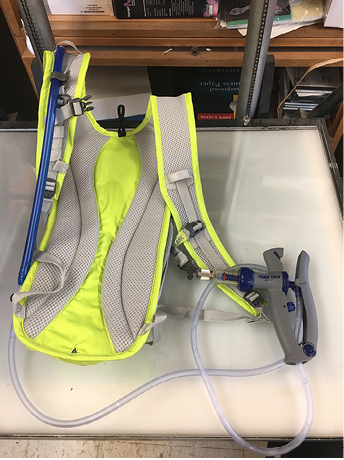Applying Herbicides with the Hack-and-Squirt Method
Herbicides are designed to be applied by several methods, the most common of which is foliar sprays. Foliage of woody vegetation, such as brush and trees, may not be easily treated with foliar sprays because of the limitations of most farm sprayers. Sprays or granular formulation applications to the soil can be effective, but these pose an increased potential for damage to nontarget plants from lateral herbicide movement or granular runoff.
Three application methods to treat woody plants that cannot be safely or conveniently sprayed are basal bark, tree injection, and hack-and-squirt applications (also called frill, girdle, or cut stem).
Basal bark applications are made to the trunk from the soil line and up 18–24 inches on the main stem or stems of multi-stem species. Herbicides are typically mixed with a petroleum-based carrier, such as diesel fuel, kerosene, or fuel oil, plus a bark penetrant and surfactant. Not all herbicides readily mix with petroleum carriers and, therefore, are not suitable for this type of application. Check the product label before attempting to mix a basal bark treatment.
Tree injection and hack-and-squirt are similar application methods, but injection requires specialized application equipment that is expensive and may not be readily available. Hack-and-squirt does not require a petroleum carrier and works with a wider variety of herbicides. See Table 1 for a list of products that can be applied with this method. The concept behind hack-and-squirt is to manually create an opening in the bark and apply herbicide to the cambium layer just inside the bark. MSU Extension Publication 2942 provides excellent instructions and images of methods to create openings for individual plant treatments.
|
Ingredient |
Examples of trade names |
Hack spacing |
Volume per incision |
|---|---|---|---|
|
2,4-D+dicamba (amine) |
Weedmaster |
continuous |
undiluted |
|
2,4-D+picloram |
Pathway, Tordon 101M |
continuous |
1 ml undiluted |
|
2,4-D (choline) + picloram |
Graslan |
continuous |
½ ml undiluted or 1 ml 1:1 ratio |
|
aminocyclopyrachlor |
Method |
2 inches |
½ to 1 ml undiluted |
|
aminopyralid+triclopyr |
Capstone/MilestoneVMPlus |
continuous |
1 ml undiluted |
|
clopyralid |
Transline |
3–4 inches |
½ ml undiluted or 1 ml 1:1 ratio |
|
dicamba (amine) |
Banvel |
continuous |
1:1 to 1:3 ratio |
|
glyphosate |
Roundup Pro |
2 inches |
1 ml undiluted or 1:1 ratio |
|
imazapyr |
Arsenal Powerline |
2–3 inches |
1 ml 2:3 ratio |
|
triclopyr (amine) |
Garlon 3A |
continuous |
1:1 ratio |
|
triclopyr (choline) |
Vastlan |
continuous |
½ ml undiluted or 1 ml 1:1 ratio |
Specialized equipment is available for hack-and-squirt applications. The Hypo Hatchet makes the incision and applies the herbicide at the same time, but this device is expensive and requires frequent cleaning to operate properly.
An axe, hatchet, or machete can be used to slash open the bark to expose the cambium layer. Apply ½ to ١ ml of herbicide, depending on label directions, inside the opening. Disposable syringes can be used to apply the herbicide, but these can be messy to fill. Syringes also can leak and make it easy to overapply herbicide in each incision.
A trigger squirt bottle can also be used, but these can be inconvenient to carry, and they may not apply the herbicide where desired. In addition, most are not tolerant of the solvents found in many herbicide formulations, so they will stop working after a few uses.
A device that works well to dispense hack-and-squirt herbicides is a hydration backpack (some examples of manufacturers include Camelbak, Osage River, iMounTEK, Ecogear, and Northwest) fitted with a line-fill livestock vaccinator (Figure 1). Hydration backpacks are available in a variety of recreational outdoor sports stores and online. Prices can be as low as $10 and go up depending on capacity and brand. Any hydration pack used for this type application should be clearly marked NONPOTABLE to prevent accidental use for drinking water.


Figure 1. Hydration backpack with line-fill vaccinator.
A line-fill vaccinator, such as the Prima Tech Premium line-fill or Allflex EM tube-fill vaccinator, is the ideal device to precisely measure herbicide for hack-and-squirt applications. The 2 ml adjustable repeating vaccinators are available from livestock supply sources (such as Stockman’s Supply and Mississippi Serum) and online vendors (such as Jeffers and ValleyVet) for less than $30. The dispensing tube of the hydration pack will likely have to be downsized and fitted to the fill tube of the vaccinator with a barbed connector from a hardware store.
This combination makes a convenient, easy-to-carry applicator that delivers a precise volume of herbicide into incisions of unwanted woody plants. When herbicides are applied in the undiluted form, product that remains in the backpack will still be effective the next time woody plants are treated.
The information given here is for educational purposes only. References to commercial products, trade names, or suppliers are made with the understanding that no endorsement is implied and that no discrimination against other products or suppliers is intended.
Publication 3276 (POD-09-21)
By John D. Byrd Jr., PhD, Extension/Research Professor, Plant and Soil Sciences.
The Mississippi State University Extension Service is working to ensure all web content is accessible to all users. If you need assistance accessing any of our content, please email the webteam or call 662-325-2262.



